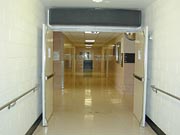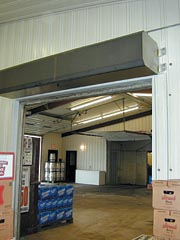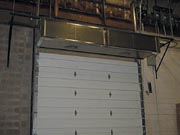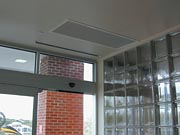
The ASHRAE Applications Handbook states that air curtains/air doors are local ventilation devices that supply a high-velocity stream of air to reduce airflow through apertures in building shells, as well as many other applications. The terms "air doors" and "air curtains" are often used interchangeably in the HVAC industry. Whichever term is used, there is generally no difference in the equipment that is specified. This article will use the term "air door" to mean air door and/or air curtain.
Advantages To Using Air Doors
Some advantages to using air doors are that they:
- Are "virtual" doors that allow efficient/effective movement of people and materials without the use of physical doors;
- Provide a thermal barrier that can be more energy efficient than other systems in providing comfortable air temperatures in the space;
- Allow unobstructed visual viewing through the opening;
- Allow light transfer from one space to the other (outside to inside and inside to outside depending on the time of day);
- Are more aesthetically pleasing than flexible plastic or rubber door strips;
- Don't physically drag across people or material being transferred through the opening; and
- Can provide more efficient and cost-effective solutions to engineering problems than other HVAC equipment or systems.

Installations/Applications
The basic applications for air doors have changed little since their development. However, creative new uses in recent years, such as separating smoking/nonsmoking sections in restaurants and air "shower" curtains in hotel guest rooms, are the result of engineers finding creative solutions to design challenges by using established products in new ways. The applications discussed herein do not present an exhaustive list of applications for air doors. The potential use of air doors is only limited to the imagination and creativity of the engineer looking for a solution to an HVAC challenge.Thermal/Climate Control: Wind blowing at a building opening causes large amounts of infiltration that can result in increased utility bills and a decrease in occupant comfort. An air door, with or without heat, can be used to effectively deflect normal wind velocities, allowing the physical door to be left open for efficient movement of people and products (Photo 1).
Insect Control: Some of the more common uses for air doors are in kitchen, restaurants, and food processing facilities where outside doors are opened frequently or are left open to let people in. Air doors prevent insects from passing through the doors by providing a curtain of high velocity air over the door opening. Air doors can also be used on interior doors in corridors leading to the outside (photo 2).
The speed at which an insect flies can be used to select the proper air door. Statistical data can be found showing the average flight speeds of various insects. This list is provided as a guide: Aeschnid Dragonfly (15.6 mph); Hornet (12.8 mph); Hummingbird Hawk Moth (11.1 mph); Horsefly (8.8 mph); Syrphid Fly (7.8 mph); Bumblebee (6.4 mph); Honeybee (5.7 mph); Housefly (4.4 mph); Damselfly (3.3 mph); and Scorpion Fly (1.1 mph).
Smoke Control/Dust Control/Fume Control: Control of air contaminants such as smoke, dust, and fumes can be a challenge in many commercial and industrial facilities. Air doors may be used to prevent the migration of contaminants from the "dirty" spaces where the contaminants are generated to the "clean" spaces.
Air Movement Control: Where there is a need to prevent air in one space from entering another space, an air door can be a very effective method of air containment. An air curtain can be used to prevent cross contamination of the two air spaces by providing a barrier that can be easily transgressed by the occupants yet not allow air exchange as would happen with a standard door.
Cold Storage: Beverage producers, food processing facilities, and cold storage warehouses frequently have bulk cold storage rooms that require access by the workers moving the products to and from these cold storage rooms. Air doors provide the unobstructed barrier between the cold storage space and the adjacent space to keep the cold air in and the warm air out (Photo 3).
Industrial Ovens: A more severe application for air doors is in industrial applications where hot processes use huge ovens. It is desirable to keep the heat in the oven while allowing the products to move efficiently in and out of the ovens. The use of air doors can be used independently or in conjunction with physical doors to retain the heat in the oven.
Dock Doors: One of the most common and oldest applications for air doors is at truck docks where materials are continuously being delivered or shipped. The air doors provide both thermal protection and insect protection. The air doors also provide better visibility for the forklift operator transporting the material (Photo 4).
Odor Control: Air doors have been effectively used to provide odor control in such spaces as trash compactor rooms. Similar applications for odor control are animal kennels, barns, or other areas where animals are housed, such as in zoos or research facilities.
Restaurant Smoking Area Separation: More cities are requiring separate smoking sections in restaurants. Air doors can be used to minimize the migration of smoke from the smoking to the non-smoking areas, while allowing customers and workers to move between the two areas.
Vehicle Washing Facilities: A common application for air doors is in car washes. The air doors used in these facilities are both vertical and horizontal and are used to force the water off of the vehicle as it exits the car wash. These air doors also help keep freezing air out of the wet car washing area, preventing the freezing of water on the floors and other surfaces. In a similar manner, on a larger scale, air doors are used in wash facilities for commercial passenger trains, buses, and aircraft.
Storage Cabinets: Some manufacturers of air doors integrate their equipment into cabinets used for storing clean or dirty products. Cabinets with air doors can also be used as work enclosures, similar to fume hoods in laboratories.
Drive-Through Windows and Concession Stands: Serving windows are opened frequently or left open continuously in drive-through fast-food restaurants and concession stands in sports facilities, public recreational facilities, amusement parks, zoos, etc. In these situations, air doors can be used for both insect control and for climate control to keep the heated or cooled conditioned air in the concession stand.
Vestibules: In some buildings it may be desirable to use a recessed mounted air door unit with an extension to the nozzle in the ceiling (Photo 5). Return air can be ducted directly to the air door or brought through a transfer grille in the ceiling. The unit can be provided with or without heat depending on the application.
Theatrical Effects: Many times in live theater or concert performances, there is a need for theatrical smoke, some other vapor effect, or a need for a wind effect on stage. Air doors can provide the directed high velocity stream of air to distribute the smoke, vapor or high velocity wind effect. The units may be mounted horizontally high above the stage, vertically on the sides or even built into a fixed or portable riser platform to provide the air or theatrical smoke at the floor level.
Unique Applications: Unique applications that require a little extra care in the application of air doors are humidity control, destratification in high ceiling areas and tempering of unconditioned make-up or combustion air entering a mechanical or boiler room. The design engineer can consult with the air door manufacturer's representative and/or factory engineers if needed, to ensure proper application of equipment for special installations.

Equipment Construction/Specifications Considerations
Housing:The typical materials used for the housing are steel, plastics, or stainless steel. Housings can be either one-piece or multipiece construction. When units are mounted outside or in areas where water, sunlight, and ambient conditions are present, the housing needs to be constructed to accommodate these conditions.Coatings: Coatings of the housing will vary by manufacturer and by application. Materials such as plastics, galvanized steel, and stainless steel don't generally need other forms of protective coatings. Standard steel units will typically require a special coating or paint. Some installations may require special painting for color requirements to meet the architectural requirements.
Fans/Drives: Fans used in larger air doors are generally centrifugal double width, double-inlet forward-curved types. Smaller units may use single width, single inlet fans. The fans can be galvanized, aluminum, plastic, or stainless steel depending on the application. The fans can be either direct- or belt-drive. Single, multiple, or variable-speed drives are also used.
Discharge Nozzle(s): The discharge nozzle typically has vanes that can be adjusted to direct the airstream in the direction that is most effective after the unit is installed. The width and length of the nozzle will determine the effectiveness of the air door as well as the location of the fan scroll discharge in relation to the air door discharge nozzle. Some installations may require nozzle or intake extensions if the unit is located above a ceiling.
Motors: Motors for air doors need to take into account the fact that these units will likely see continuous-duty demand applications. The motors can be resiliently mounted and can be TEFC, ODP, TEAO, or explosion-proof depending on the application.
Control Options: The control of an air door can be activated by a variety of inputs including door switches, thermostats, on/off switches, HOA switches, high/low switches, programmable thermostats, motion detectors, flow switches, differential pressure switches, etc. Some manufacturers offer time-delay relay devices to allow the air door to stay activated for an adjustable period of time after the initial activation of the unit. Some manufacturers also offer optional accessories like disconnect switches, control transformers, and motor starters in control cabinets.
Mounting Accessories: Air doors can be factory equipped with mounting brackets or integral-mounting hardware. Some manufacturers provide mounting hardware as standard features built into the housing while others require more elaborate external mounting hardware and brackets. Units can be mounted either horizontally or vertically. Care must be taken to specify the appropriate mounting method in seismic zones and other areas that require special bracing of HVAC equipment.
Filters: Depending on the application, filters may or may not be needed. Some manufacturers will provide holding frames for whatever filter type is desired to meet the filtration requirements.
Heating Options: The heat source for air doors may be electric, hot water, steam, oil burners, or either direct or indirect gas-fired heaters.
Standards: There are a few industry standards that can be specified for air door units. Some of these standards are: AMCA 220 "Test Methods for Air Curtain Units," ARI 410 "Forced-Circulation Air-Cooling and Air-Heating Coils,"and NSF 37 "Air Curtains for Entranceways in Food and Food Service Establishments."
Other industry standards may be used to specify the accessories that are part of the air door units such as the filters, coils, burner assemblies, etc. Some units may require compliance with USDA and FDA standards for use in food processing, kitchen, or restaurant applications. Some jurisdictions require units to be either UL Listed or ETL Tested in accordance with UL standards. Some manufacturers have units that are AMCA Air Certified; however, this usually applies to the larger units.
Performance - Air/Noise: The actual airflow capacity will depend on the application functional requirements. A performance-based specification may be appropriate for selecting air doors to ensure that the end result satisfies the design criteria. Although there is not an AMCA standard for noise measurement for air door equipment, some manufacturers publish noise level data based on a free field factory test that can be used with engineering discretion.
Warranty: Manufacturers generally provide a standard one-year parts warranty; however, extended warranties can be provided.
Submittals: Manufacturers of air doors can provide product data sheets showing the performance and construction features of their products. Installation and O&M instructions can be provided as well as certified construction drawings if needed.
Demonstration/Commissioning: As with other HVAC installations, the end result is the most important aspect of the design. The design intent should be specified in a manner that provides measurable results at the actual installation. It may be found that some air doors cannot provide the required level of performance when uniformity of coverage and energy efficiency are used as the design performance criteria.
Manufacturers: There are several manufacturers of air doors. They may be located by contacting local sales representative agencies, Internet searches using common search engines, industry master specification services, industry product equipment resource guides, etc.

Design Intent
The intent of an air door is generally to provide full coverage of the opening; therefore, high outlet velocity uniformity over the entire opening is one of the primary objectives of selecting air doors.The figures show how the design of the fan discharge and nozzle of an air door unit may provide different degrees of effectiveness of coverage over the entire opening. Figure 1 shows that if the fan scroll discharge is too close to the nozzle, the unit may have alternating high velocity and low (or no) velocity spots across the length of the nozzle. Figure 2 shows other product designs that provide extended plenum-type fan discharges that allow the air to distribute more evenly before being discharged from the nozzle.
Another design intent is to get the airstream to deflect in the correct direction, either into or out of the space being protected. Figure 3 shows an air door being used to prevent wind, insects, or particulate matter from entering a building. Figure 4 shows the air door being used to keep the conditioned or contaminated air in one space and not allowing it to migrate to the adjacent space.
Sizing Air Doors
As with any mechanical equipment, it is essential to establish the design criteria before selecting the equipment. With air doors it is essential to determine the function of the barrier (climate control, thermal barrier, contaminate control, insect control, odor control, etc.). A barrier intended to control the movement of flies through a kitchen door may use a different model than a barrier intended to stop cold winds from entering. Sizing considerations need to take into account several factors:
- The objective of the air door - what is being controlled and why;
- The size of the door (width and height);
- Differential pressure between spaces;
- Wind velocity;
- Contaminant being controlled;
- Heating requirements and heat sources available; and
- Obstructions around the door that would interfere with installation and/or performance.
Air doors essentially provide a resistance or force that is intended to change the direction of another force that comes into contact with it. Basic laws of physics apply when analyzing the air mass and velocity of this air mass. The ASHRAE Applications Handbook provides some theoretical formulas for determining the airstream needed in an air door application. Many manufacturers have selection guides, charts, and graphs that have been developed through both calculations and years of practical application experience to help the design engineer select and specify the correct model for the application.
Installation Considerations
Where air doors are being used at the perimeter of a building, there are frequently other types of doors to contend with. Special care must be taken in sizing the unit and adjusting the discharge nozzle angle after installation to account for the air door nozzle not being positioned directly over the door. Figure 5 shows examples of air doors mounted with different door types. Vertical-mounted air doors require similar coordination with building components at the sides of the door.
Another factor to consider is seismic bracing of the units. Manufacturers of air door equipment don't generally provide seismic bracing accessories. Supporting air doors directly from the structure may require less seismic bracing than units suspended from long rods from the structure above.

Conclusion
Air doors can be applied to any application where there is a need to separate spaces or processes for just about any purpose. Creativity in their application starts from the first day of design when the project functional criteria are being established. Air doors provide unique solutions to HVAC challenges in a more cost-effective and energy-conscious manner than some of the traditional equipment and systems that engineers and contractors use out of habit.
Using air doors is often overlooked when engineers and facility owners look for solutions to these HVAC challenges. Sometimes more elaborate HVAC systems are used when a simple air door would provide an energy efficient and effective solution at a reduced installed cost. Whether it is wind, heat, cold, air contaminants, odor, insects, etc., air doors may offer the better engineered system to the HVAC challenge. Engineers may find that the habit of using unit heaters and other more elaborate HVAC systems needs to be reconsidered and discover that using air doors is the wiser choice.ES
EDITOR'S NOTE: Some of the images associated with this article do not transfer to the Internet. To review the figures, please refer to the print version of this issue.
